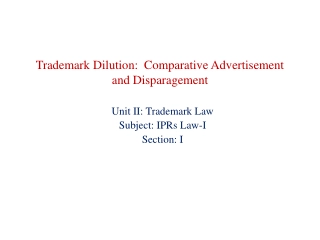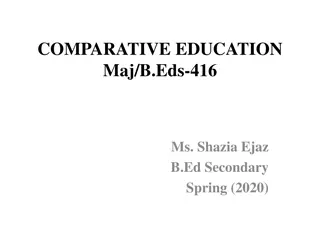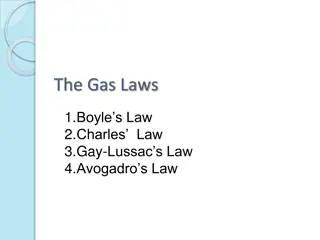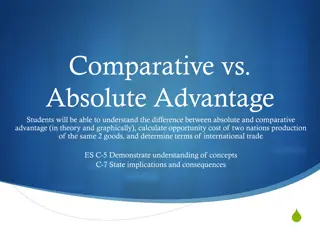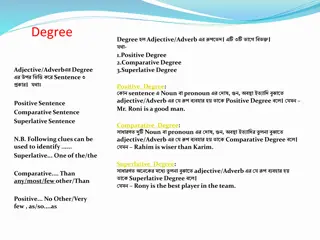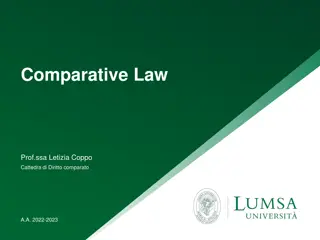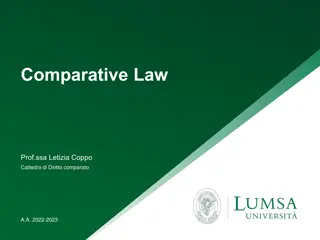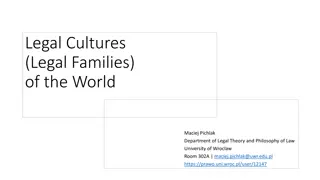The Evolution of Comparative Law in Globalized Society
Comparative law delves into the diverse legal systems worldwide, aiming to identify convergences and divergences, promoting harmonization and understanding in an increasingly globalized world shaped by technological and digital advancements.
Download Presentation

Please find below an Image/Link to download the presentation.
The content on the website is provided AS IS for your information and personal use only. It may not be sold, licensed, or shared on other websites without obtaining consent from the author. Download presentation by click this link. If you encounter any issues during the download, it is possible that the publisher has removed the file from their server.
E N D
Presentation Transcript
Comparative Law Prof.ssa Letizia Coppo
I THE CONCEPT OF COMPARATIVE LAW Starting point: legal rules are not identical anywhere in the world and the solutions adopted to legal problems vary from system to system Definition of comparative law: the science that studies law (i.e. the different legal systems of the world*) through the comparative method. *a legal system is more than just a set of legal rules; and law is not reduced to legislation
THE TWO LEVELS OF COMPARISON 1. Macro-comparison: comparison on a large scale; it deals with the spirit and style of different legal systems, i.e. methods of handling legal materials, procedures for resolving and deciding disputes or the role of the various legal players, and the like. 2. Micro-comparison: comparison on a small scale, i.e. focused specific legal institutions or problems, in other words, on the rules applied to actual problems or particular conflict of interests N.B.: the dividing line is flexible and the two levels intertwine.
THE RISE OF COMPARATIVE LAW Time and location: international Congress for Comparative Law (Paris, 1900) organized by Eduard Lambert and Raymond Saleilles Context: fall of the jurists illusion to live in the best legal system , the only one worth analysing; widespread trust in progress; trend towards universality.
THE AIMS OF COMPARATIVE LAW IN A NUTHSELL Original aims: tobuild a common law of mankind (droit commun de l humanit ); to reduce the accidental and divisive divergences in the laws of countries that have reached the same stage of cultural and economical development (Lambert). Current aim: toperceive the real and apparent convergences and divergences in the laws of the various legal systems on a global scale.
COMPARATIVE LAW AND LAW GLOBALISATION Main triggers of law globalisation The technological revolution reduced the physical distance among countries, encouraging people to travel cross-borders The digital revolution increased the transnational dimension of exchanges.
COMPARATIVE LAW AND LAW GLOBALISATION The impact of globalisation on law Circulation of laws (the so-called legal transplants) Need for uniformity and harmonisation Sources pluralism and complexity Circulation of contractual models ( aliencontracts ) Transfer of functions from the State to the Market Creation of a third legal order named lex mercatoria Cultural cross-contamination
COMPARATIVE LAW AND NEIGHBOURING SCIENCES 1. Comparative Law and Conflict Private international law Conflict of laws rules are part of the positive domestic law. They do not compare and contrast laws but provide criteria to identify which law applies to a legal relationship that has foreign connections. Comparative law is useful in the process of qualification or characterization of connecting factors (qualification according to the lex fori v. qualification in the light of comparative law)
COMPARATIVE LAW AND NEIGHBOURING SCIENCES 2. Comparative Law and Uniform Private international law Uniform Private international law is again part of domestic law or at least an optional tool that parties can choose to regulate their relationships on the basis of a common set of rules. Comparative Law can both promote further attempts of harmonisation by highlighting shared problems and suggest uniform solutions; and facing the challenge of granting a uniform interpretation of such rules (see below)
COMPARATIVE LAW AND NEIGHBOURING SCIENCES 3. Comparative Law and Public international law Public international law is a supranational and global system of law, the players of which are States and International Organisations. Comparative Law plays a leading role with regard to international law sources: it improves the understanding of the general principles of law recognized by civilized nations ; it helps finding progressive solutions capable of becoming general principles of law.
COMPARATIVE LAW AND NEIGHBOURING SCIENCES 4. Comparative Law, Legal History and Legal Ethnology Legal history may adopt a comparative method but in a diachronic rather than a synchronic perspective. Legal Ethnology focuses on the legal features of existing uncivilized societies, trying to unearth the typical and atypical factors which contribute to their evolution.
COMPARATIVE LAW AND NEIGHBOURING SCIENCES 5. Comparative Law and Legal Sociology Legal Sociology aims at understanding the causal mutual relationships between law and society and identify the patterns from which one can infer whether and under what circumstances law affects human behaviour and how law is affected by social change. Comparative law and legal sociology need to interact in the sight of a more accurate definition of the problems and the unveiling of possible cultural biases (see the link between legal evolution and social changes).
THE ROLE OF COMPARATIVE LAW IN CONTEMPORARY SOCIETY General remarks: like all sciences, comparative law is aimed at providing knowledge. It extends and enriches the supply of solutions and improves the scholars critical capacity to find the best one. In particular, comparative law is: 1. an aid to the legislator 2. a useful tool of construction 3. a fundamental step of legal education 4. a tool for law unification and harmonisation. 5. a glimpse into the common roots of the European legal tradition.
THE ROLE OF COMPARATIVE LAW IN CONTEMPORARY SOCIETY 1. Comparative Law as an aid to the legislator Legislators have found that on many matters good laws cannot be produced without the assistance of comparative law, whether in the form of general studies or of reports specially prepared in the topic in question. Instances: XIX century unification of German Law (private law, civil procedure, criminal law, bankruptcy law, court system organisation); dissolution of former Soviet Union countries.
THE ROLE OF COMPARATIVE LAW IN CONTEMPORARY SOCIETY The problem of legal transplants: the reception of foreign models may raise problems and even lead to rejection, due to the inevitable differences in courts procedures, the power of the local authorities, economy or general context. Efficiency test: in order to assess the success chance of a transplant one should answer to the following questions: 1. whether the model has proved satisfactory in its home country; 2. whether the model is likely to work in the receiving country.
THE ROLE OF COMPARATIVE LAW IN CONTEMPORARY SOCIETY 2. Comparative Law as a tool for interpretation Key question: are national jurists entitled to a comparative-law-oriented or a harmonisation-oriented interpretation of domestic legislation? Possible answer - Such interpretation cannot turn into a circumvention of national law. - So, jurists are entitled to such interpretation provided that they use it to fill the gaps of domestic law. - Regardless of gaps, comparative interpretation can always be an argument to select between the two possible meanings of an ambiguous provision.
THE ROLE OF COMPARATIVE LAW IN CONTEMPORARY SOCIETY Furthermore interpretation seems to be allowed in some countries* Comparative-law-oriented or harmonisation-oriented * As to legislation, see the Swiss Civil Code, art. 1, pars 2 e 3: if no statutory provisions can be found, the judge must apply customary law, failing which he must decide according to the rule he would, were he a legislator, decide to adopt. In so doing the judge must follow accepted doctrine and tradition
THE ROLE OF COMPARATIVE LAW IN CONTEMPORARY SOCIETY And actually courts do use comparative law as an interpretative tool in many cases, also through the quotation of foreign precedents* See, e.g. the influence of French case-law on the issue of wrongful birth / wrongful life. Or see the English case Interfoto Picture Library v. Stiletto Visual Programmes (available within the course materials), about good faith in precontractual negotiations.
THE ROLE OF COMPARATIVE LAW IN CONTEMPORARY SOCIETY Further questions In using the suggested method, are we entitled to look also to systems which are not so close to our tradition? Can the judge choose whichever of the foreign solutions seems to him the best or can he choose only a solution which is common to a number of other systems? Are we entitled to choose an interpretation of our legal rules independent from the conceptual structure of our own system?
Comparative Law Prof.ssa Letizia Coppo
THE ROLE OF COMPARATIVE LAW IN CONTEMPORARY SOCIETY The role of comparative law in the interpretation of uniform law Facing uniform law, judges need to free themselves of whatever homeward trend and pursue an autonomous interpretation. Sometimes such interpretation is provided by an ad hoc common Supreme Court (e.g. the Court of Justice of the European Union). Sometimes not, so comparative method becomes necessary: as a laboratory of outward trend and autonomous interpretation, see the CISG case.
THE ROLE OF COMPARATIVE LAW IN CONTEMPORARY SOCIETY 3. Comparative law as a fundamental step in legal education Benefits of a comparative law background - Improved awareness and respect of other cultures - Better understanding of domestic law - Learning of practical skills useful for facing the challenges of the globalisation of legal professions.
THE ROLE OF COMPARATIVE LAW IN CONTEMPORARY SOCIETY 4. Comparative law as a tool for law unification and harmonisation In identifying the real and apparent convergences and divergences among the various legal systems and reporting them, comparative law experts play a paramount role in promoting the unification and harmonisation of law. Think of scholarly initiatives like Unidroit or PECL or UNCITRAL or the Common Core; or think of the CISG Advisory Council or the Lawyer Linguists working at the European Union.
THE ROLE OF COMPARATIVE LAW IN CONTEMPORARY SOCIETY Reasons for and against unification: where uniformity v. divergence becomes unity in diversity Pros Cons Conflicts of legal rules and unfamiliarity with them hinder exchanges Divergences increase cultural and linguistic complexity No progress without variation, as progress comes from situations of disequilibrium and pursues an equally dynamic asset Risk of losing identity (see unbalanced harmonisation in contract law)
THE ROLE OF COMPARATIVE LAW IN CONTEMPORARY SOCIETY The possible methods for unification / harmonisation Finding what is common to the jurisdictions concerned and incorporating that in the uniform law; Where there are areas of difference, adopting the best existing variant or finding, through the comparative method, a new more efficient and easily applicable solution (here preparatory reports are fundamental).
THE ROLE OF COMPARATIVE LAW IN CONTEMPORARY SOCIETY The core divergences to be investigated in comparing legal systems The presence or absence of an authority provided with legislative power (see Islamic and African systems) The existence of jus and jurists as autonomous figures The existence of a State (diffuse power societies / centralised power structures; see Chinese dispute settlement) The relationship with supernatural (see e.g. trial by ordeal) The degree of personalisation of law and legal pluralism
THE ROLE OF COMPARATIVE LAW IN CONTEMPORARY SOCIETY The possible techniques for unification / harmonisation and their merits Hard law: multilateral treaties, EU regulations and directives Soft law (stricto sensu): model laws; recommendations; green books, and the like Practice; usages; codes of conduct Case-law: quotation of persuasive foreign precedents
THE METHOD OF COMPARATIVE LAW Starting point: legal systems may have formally identical rules and though solve the same problem in different ways; or have formally different rules and reach the same results in their application. Comparative law as a both a method of thinking and a method of working. First golden rule of comparative method: comparison must never be restricted to normative provisions or remain confined to a formal level. One thing are rules, another one is how they are interpreted and applied. Concept of legal formants: a legal system is the result of the interaction among various forces or factors that mutually influence each others.
THE METHOD OF COMPARATIVE LAW Main legal formants: legislation; scholarship; case law. Such formants often overlap, raising problems of legitimacy, and often contain other formants (e.g. in judicial decisions we can distinguish between the held, the applied rule, the ratio decidendi and the obiter dictum). Formants and comparative method: comparative lawyers must: distinguish between operational rules and how the rules are conveyed; discern the various formants and understand their role. Kryptotypes: formants which are implied in the system (and may be expressed in other systems); one thing is following rules, another is being aware of them.
THE METHOD OF COMPARATIVE LAW Legal provisions = norms + interpretation. Different types of norms Not all norms are rules of conduct: some of them define concepts, others set principles, others provide sanctions. Not all rules of conduct are incorporated in one single provision or in provisions of the same kind. Often part of the rule is established in general and abstract norms, the other in specific norms; and those two regimes may not change simultaneously.
THE METHOD OF COMPARATIVE LAW Steps of the comparative method process 1. Choose what systems to compare (i.e. the term of comparison): here the key-word is functionality, which tells you what laws to compare and the scope of the undertaking 2. Identify the legal problems you want to compare and contrast (i.e. the object of comparison) 3. Identify the relevant material and sources for comparison (i.e. where to look in the foreign systems) 4. Build a system 5. Assess findings critically
THE METHOD OF COMPARATIVE LAW 1. The choice of the term of comparison Focus on the parent system rather than / prior to the affiliate system (but bear in mind that to qualify a system as a mere affiliate is a delicate matter) First look at the parent system of the great legal families Choose according to the features of each system and the nature of the problem you want to analyse (have a look at national law reviews to get a grasp of hot topics)
THE METHOD OF COMPARATIVE LAW 2. The choice of the object of comparison Do not jump to the conclusion that the problem is unknown to the foreign system Rethink the original question purging it of all dogma from your system Eradicate preconceptions of your native legal system Do not underestimate the refinement of non continental legal system (see the example of trust) If the problem is really is unknown, then wonder why
THE METHOD OF COMPARATIVE LAW 3. The choice of the sources an materials to compare Avoid all limitations and restraints, especially with reference to sources (both imagination and discipline are needed) Bear in mind that sometimes legal systems solve problems with extra- legal means (see the example of the sending/receipt rule as to the question when an offer is considered as binging). Presumption of similarity: tells you where to look and whether convergences and divergences are real or only apparent.
THE METHOD OF COMPARATIVE LAW 5. The building of a system Draft separate reports for all the legal systems you have compared Comment each report Adopt a new viewpoint freeing each solution from their context and looking at them in light of their functions Develop a special syntax and vocabulary with concepts wide enough to embrace heterogeneous legal institutions functionally comparable Check the coherence of the system
THE METHOD OF COMPARATIVE LAW 6. The critical assessment of findings Build a structure and all the conceptual apparatus for ordering, organising and transmitting its materials after having induced it through constant experiments of comparative law. Create topical and categories
THE METHOD OF COMPARATIVE LAW Comparative Law and language: sometimes systems use concepts or words that do not find their mirror ones in other systems, as they do not belong to their legal categories or legal vocabulary (e.g. equity, zar ). What must be borne in mind is that legal concepts belong to two systems: the linguistic and the legal one. Problems of translation: different systems have different linguistic structures and different rhetoric figures (e.g. contract and contrat) and they are full of false friends and traps.
THE METHOD OF COMPARATIVE LAW Possible solutions to translation problems: Sometimes it is better not to translate the concept, leave it in its original language; Sometimes there is a semantic and conceptual correspondence Sometimes it is necessary to measure the divergence in meaning and assess whether it undermines the understanding of the concept Sometimes a neologism is needed.
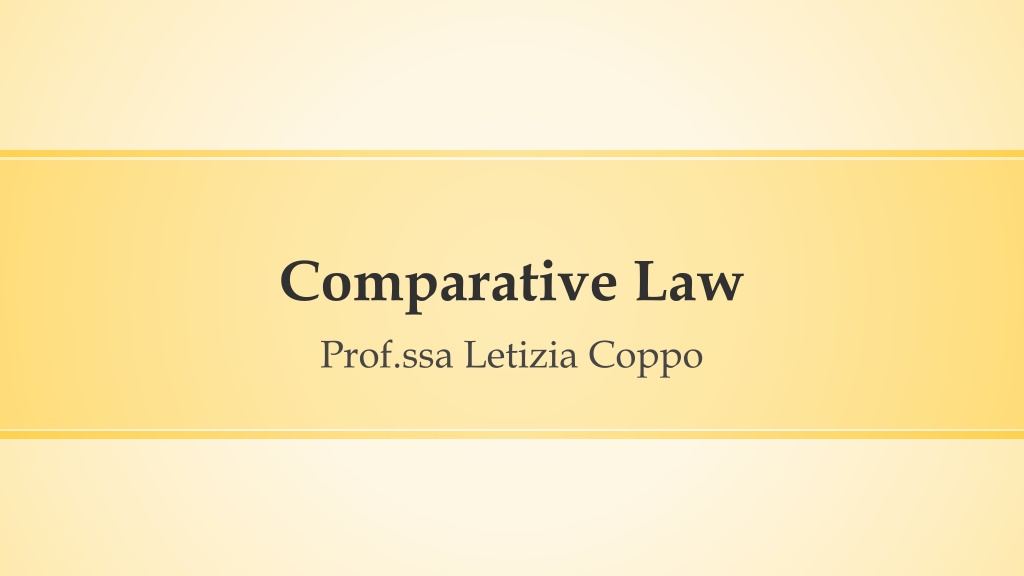
 undefined
undefined





